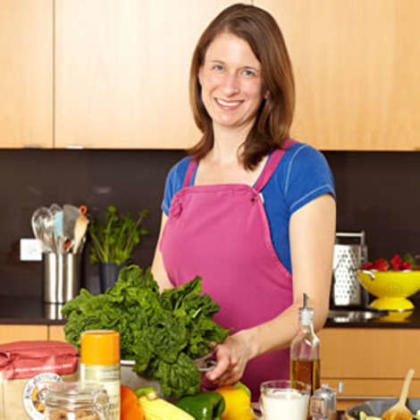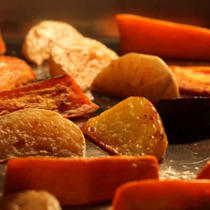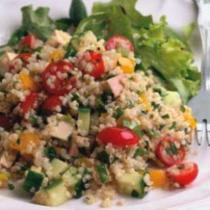6 Ways Cook Healthier in 2014

By Hilary Meyer, Associate Food Editor, EatingWell Magazine
If you're resolving to eat healthier this year, consider starting in the kitchen. Mastering a few easy cooking skills can do wonders for your health and your waistline. Here are a few simple tips to get you started:

1. Be a Breakfast Chef
Regular breakfast eaters tend to be leaner, and breakfast-eating dieters are more successful at losing weight. What's more, studies have found that they also get more fiber, calcium, vitamins A and C, riboflavin, zinc and iron-and less fat and dietary cholesterol. But the key is a balanced breakfast. That means having whole grains, protein, low-fat dairy and a serving of fruit or veggies. The best way to achieve this is by making your own breakfast. It won't take you more than 10 minutes-really! Try oatmeal topped with fruit. Or scramble an egg with a little cheese and some chopped spinach. The more you make breakfast at home, the more routine it becomes.
Don't Miss: 10-Minute Breakfast Recipes

2. Roast Your Vegetables
We hear it over and over again: "Eat more vegetables!" That's easy for some people, but for others who may be new to healthy cooking, getting vegetables to taste good can be a challenge. That's why you should master roasting. It's easy, plus it transforms even die-hard veggie haters into veggie lovers! Roasting vegetables intensifies their flavor and brings out their natural sweetness as the heat from the oven caramelizes the natural sugars. And it's a healthy way to cook, since you need only minimal oil to get fantastic flavor and only a cookie sheet for equipment. What the key to perfect roasted vegetables? A hot oven (around 425ºF), a light coating of oil (toss your veggies with about 1 tablespoon olive oil per 4 cups raw) and a sprinkling of salt (about ¼ teaspoon per 4 cups). All veggies taste great roasted, but a few that really shine are broccoli, cauliflower and Brussels sprouts.
Don't Miss: 3 Steps to Perfectly Roasted Vegetables

3. Make Your Own Snacks
Snacking can be part of healthy diet as long as you choose your snacks wisely. Prepackaged snacks can be loaded with salt, sugar and fat, all of which you should limit if you are trying to eat more healthfully. So why not make your own snacks at home? Throw together a mix of nuts and dried fruit to munch on, or pop some popcorn and portion it out into single serving bags (about 1½ cups each) to keep you satisfied between meals. The prep won't take you more than 5 minutes, and you won't be tempted to grab an unhealthy snack from the checkout line when you're in a hurry.
Don't Miss: Easy 100-Calorie Snack Recipes

4. Master Quick-Cooking Whole Grains
Eating whole grains keeps you feeling full longer and may also help lower your risk of heart disease. But what keeps many people from cooking them is time (some can take over an hour!). So resolve to learn how to cook some of the quicker-cooking whole grains like quinoa, farro and bulgur. Little grains of quinoa cook up in about 20 minutes. Bulgur takes about 10 if you simmer it on the stove and farro takes between 15 and 30 (depending on the type). Add a pinch of salt, a squeeze of lemon and a teaspoon or two of fresh herbs and you have a fast whole-grain side dish to complement just about anything. And keep in mind that you can also reap the benefits of whole grains by choosing whole-wheat pasta and couscous. Both offer more fiber than white varieties, and they're quick-cooking.
Related: Quick Whole-Grain Recipes

5. Slash Salt
Most of us eat too much salt. The general recommendation for most people is 2,300 mg a day. Yet 90 percent of Americans get way more than that, an excess that can lead to high blood pressure and heart disease. Most of the extra salt in our diets comes from processed foods, like broth and canned tomatoes. Read the labels and aim to buy reduced, low-sodium and no-salt-added versions of products that are traditionally high in salt. There are also cooking tricks that can help lower your sodium intake. Experiment with adding flavor-packed salt alternatives, such as vinegar, lemon, garlic or herbs. The added zing they each bring will make it less obvious that there is less salt in your dish.

6. Cook with Cast Iron
If you want to cut back on fat when you're cooking, invest in a good cast-iron pan. They are relatively inexpensive, and the ultra-smooth surface prevents food from sticking and burning without the need for tons of oil. Plus, you get the added benefit of an iron boost if you cook acid ingredients (like tomatoes). Cast-iron pans are low maintenance too-just make sure to dry them thoroughly before storing.
What's your new healthy cooking habit?
By Hilary Meyer

EatingWell Associate Food Editor Hilary Meyer spends much of her time in the EatingWell Test Kitchen, testing and developing healthy recipes. She is a graduate of New England Culinary Institute.
Related Links from EatingWell:
